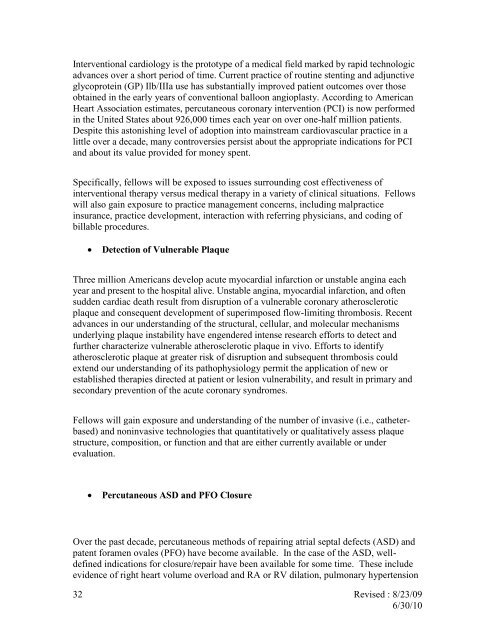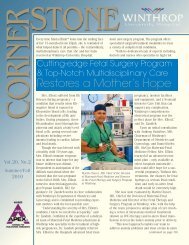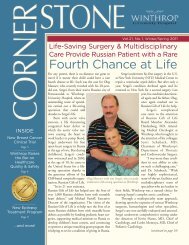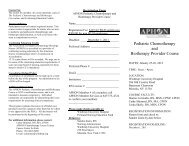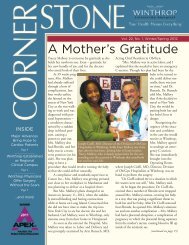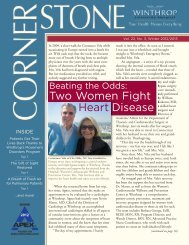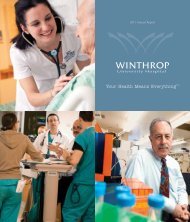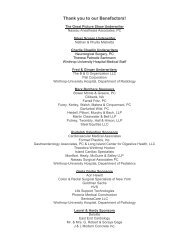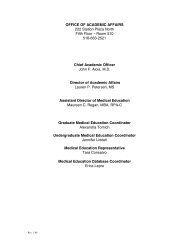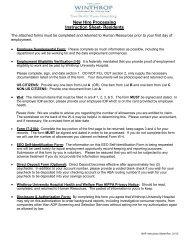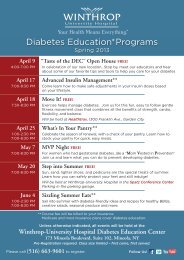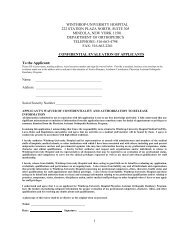interventional cardiology fellowship curriculum - Winthrop University ...
interventional cardiology fellowship curriculum - Winthrop University ...
interventional cardiology fellowship curriculum - Winthrop University ...
Create successful ePaper yourself
Turn your PDF publications into a flip-book with our unique Google optimized e-Paper software.
Interventional <strong>cardiology</strong> is the prototype of a medical field marked by rapid technologic<br />
advances over a short period of time. Current practice of routine stenting and adjunctive<br />
glycoprotein (GP) Ilb/IIIa use has substantially improved patient outcomes over those<br />
obtained in the early years of conventional balloon angioplasty. According to American<br />
Heart Association estimates, percutaneous coronary intervention (PCI) is now performed<br />
in the United States about 926,000 times each year on over one-half million patients.<br />
Despite this astonishing level of adoption into mainstream cardiovascular practice in a<br />
little over a decade, many controversies persist about the appropriate indications for PCI<br />
and about its value provided for money spent.<br />
Specifically, fellows will be exposed to issues surrounding cost effectiveness of<br />
<strong>interventional</strong> therapy versus medical therapy in a variety of clinical situations. Fellows<br />
will also gain exposure to practice management concerns, including malpractice<br />
insurance, practice development, interaction with referring physicians, and coding of<br />
billable procedures.<br />
<br />
Detection of Vulnerable Plaque<br />
Three million Americans develop acute myocardial infarction or unstable angina each<br />
year and present to the hospital alive. Unstable angina, myocardial infarction, and often<br />
sudden cardiac death result from disruption of a vulnerable coronary atherosclerotic<br />
plaque and consequent development of superimposed flow-limiting thrombosis. Recent<br />
advances in our understanding of the structural, cellular, and molecular mechanisms<br />
underlying plaque instability have engendered intense research efforts to detect and<br />
further characterize vulnerable atherosclerotic plaque in vivo. Efforts to identify<br />
atherosclerotic plaque at greater risk of disruption and subsequent thrombosis could<br />
extend our understanding of its pathophysiology permit the application of new or<br />
established therapies directed at patient or lesion vulnerability, and result in primary and<br />
secondary prevention of the acute coronary syndromes.<br />
Fellows will gain exposure and understanding of the number of invasive (i.e., catheterbased)<br />
and noninvasive technologies that quantitatively or qualitatively assess plaque<br />
structure, composition, or function and that are either currently available or under<br />
evaluation.<br />
<br />
Percutaneous ASD and PFO Closure<br />
Over the past decade, percutaneous methods of repairing atrial septal defects (ASD) and<br />
patent foramen ovales (PFO) have become available. In the case of the ASD, welldefined<br />
indications for closure/repair have been available for some time. These include<br />
evidence of right heart volume overload and RA or RV dilation, pulmonary hypertension<br />
32 Revised : 8/23/09<br />
6/30/10


